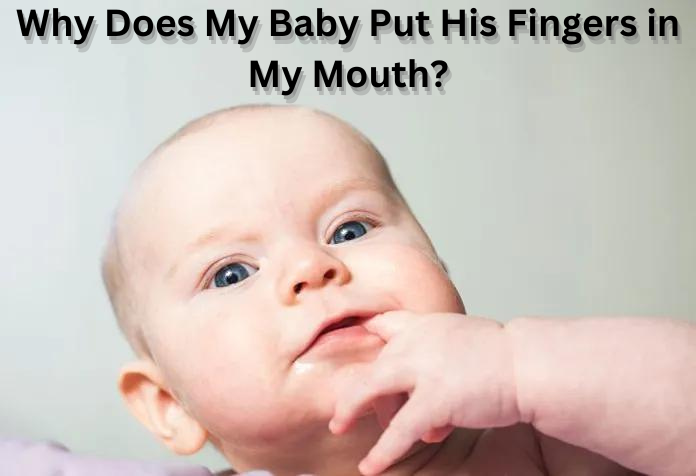Why Does My Baby Put His Fingers in My Mouth?
Table of Contents
- Introduction
- Understanding Baby Behavior
- The Science Behind Babies’ Actions
- Why Babies Put Fingers in Your Mouth
- Examples of This Behavior in Daily Life
- Is It Normal?
- What to Do When It Happens
- When to Be Concerned
- Conclusion
- FAQs
Introduction
If you’re a new parent, you might find yourself asking, “Why does my baby put his fingers in my mouth?” Babies do all sorts of curious things, and this behavior might seem a bit odd or even amusing at first. However, like many of their actions, there’s usually a reason behind it. This article explores why babies engage in this behavior, what it means, and whether or not you should be concerned. We’ll dive into the science behind it, share examples, provide helpful tables for quick understanding, and offer guidance on how to respond when your baby sticks those tiny fingers in your mouth.
Understanding Baby Behavior
Babies are constantly learning about the world around them. Since they can’t yet ask questions or express themselves fully through words, they explore their environment using their senses—especially touch and taste. By placing objects, including fingers, into their mouths, they gather information about the object’s texture, taste, and temperature.

Key Aspects of Baby Behavior
| Aspect | Description | Example |
|---|---|---|
| Curiosity | Babies have an innate desire to explore and understand their surroundings. | A baby reaching out to touch and taste a new toy they’ve never seen before. |
| Sensory Exploration | Using senses like touch and taste to learn about objects and people. | Putting various objects, including their own hands, into their mouth to feel different textures. |
| Comfort Seeking | Engaging in actions that provide a sense of security and soothe discomfort or stress. | Sucking their thumb or a pacifier when they feel tired or uneasy. |
| Imitation | Copying behaviors they observe from people around them to learn and connect. | Trying to hold a spoon and mimic eating after watching their parents during mealtime. |
Example: Imagine your baby grabbing your finger and immediately bringing it to their mouth. They’re not only exploring the sensation but also seeking comfort and bonding with you through this simple action.
The Science Behind Babies’ Actions
Babies’ brains are wired to explore and absorb information rapidly during their early development stages. One significant phase that explains much of this mouth-centered exploration is the oral stage.
Understanding the Oral Stage
| Feature | Details | Example |
|---|---|---|
| Definition | A developmental phase where babies explore the world primarily through their mouths. | A 6-month-old baby chewing on toys, blankets, and even their toes as part of exploring different sensations. |
| Importance | Crucial for sensory development, helping babies understand various textures, tastes, and objects, contributing to cognitive growth. | Recognizing the difference between soft and hard objects by mouthing them, which later helps in food introduction and speech development. |
| Duration | Typically spans from birth up to around 18 months of age. | A 1-year-old still putting objects in their mouth but gradually decreasing as they begin to explore more with their hands and eyes. |
| Psychological Aspect | Proposed by Freud, suggesting that pleasure centers around the mouth during this stage, influencing future behaviors and personality traits. | Sucking on a pacifier providing comfort and security, potentially affecting how the child manages stress in later life. |
Example: When you offer your baby a new, colorful teething ring, they’ll likely put it straight into their mouth. This action helps them understand what the object is, how it feels, and whether it’s soothing for their teething discomfort.
Why Babies Put Fingers in Your Mouth
There are several reasons why your baby might put his fingers—or even yours—in your mouth. Understanding these reasons can help you respond appropriately and support your baby’s development.
Common Reasons and Explanations
| Reason | Explanation | Example |
|---|---|---|
| Exploration | Babies are curious and use their mouths to learn about different objects and people. Putting fingers in your mouth helps them discover new sensations and understand more about you. | While cuddling, your baby touches your lips and inserts their fingers into your mouth, feeling the warmth and movement, thus learning more about human features and reactions. |
| Teething | The pressure from biting or chewing helps soothe sore gums during teething. Your fingers might provide the perfect texture and resistance for relief. | Your 7-month-old starts gnawing on your knuckle during a diaper change, indicating that their gums are bothering them and they find comfort in the pressure your finger provides. |
| Bonding | This behavior can be a way for babies to connect and interact with you, strengthening the emotional bond through close and personal contact. | During playtime, your baby giggles and reaches to put their fingers in your mouth, enjoying the shared laughter and closeness it brings between you both. |
| Imitation | Babies learn by copying those around them. Seeing you eat or put things in your mouth encourages them to mimic the action as a form of learning and engagement. | At dinner, your baby watches you take a bite of food and then reaches out to touch your mouth, attempting to imitate your eating behavior and participate in the mealtime ritual. |
| Seeking Attention | Noticing that certain actions elicit reactions, babies repeat behaviors like putting fingers in your mouth to gain attention and interact more with you. | You laugh when your baby playfully puts their fingers in your mouth, so they continue doing it to keep the fun interaction going and maintain your focus on them. |
| Comfort and Security | The act can be soothing, providing a sense of safety and reassurance, especially in unfamiliar or stressful environments. | In a crowded and noisy place, your baby may put their fingers in your mouth to seek comfort and feel connected to you amidst the chaos. |
Detailed Example: Suppose you’re reading a book to your baby, and they reach out to touch and insert their fingers into your mouth. This action could stem from multiple reasons: they’re exploring the movements and sounds as you read aloud, imitating speaking behaviors, and also seeking a deeper connection during this shared activity.
Examples of This Behavior in Daily Life
Understanding real-life scenarios can help you relate better to this behavior and know how to handle it effectively.
Daily Life Scenarios
| Scenario | Description | How to Respond |
|---|---|---|
| Morning Cuddles | During your morning routine, while holding your baby close, they start to playfully put their fingers in your mouth, exploring and enjoying the closeness. | Embrace the moment as a bonding experience, but if uncomfortable, gently redirect their hands to a toy or another activity while maintaining the affectionate interaction. |
| Feeding Time | While breastfeeding or bottle-feeding, your baby reaches up and touches your mouth, sometimes inserting their fingers inside as a way to explore and engage with you during feeding. | Allow gentle touches as part of bonding, but ensure hands are clean. If it interferes with feeding, softly guide their hand back or offer a soft toy to hold during feeding. |
| Play Dates with Other Babies | Observing other babies, your child notices and imitates behaviors like putting fingers in parents’ mouths, trying it out themselves to see the reaction and engage in social learning. | Monitor interactions to ensure safety and hygiene, encourage positive social behaviors, and provide appropriate toys for exploration. Use the opportunity to teach gentle touch and respectful interactions. |
| During Diaper Changes | Lying on the changing table, your baby might reach out to your face, inserting fingers into your mouth as a way to distract themselves from the discomfort or boredom of diaper changes. | Keep their hands occupied with a favorite toy during diaper changes. If they attempt to put fingers in your mouth, gently redirect and make the experience fun with songs or silly faces to keep them entertained without needing to use their hands. |
| In New Environments | Visiting a new place, your baby feels uncertain and seeks comfort by maintaining close contact, which includes putting their fingers in your mouth to reassure themselves of your presence and support. | Offer extra cuddles and speak in soothing tones to provide comfort. Gently hold their hand and reassure them through words and gentle touches, reducing the need for them to seek comfort through mouth contact. |
Example in Context: During a family gathering, your baby may feel overwhelmed by new faces and sounds. They reach out to you, placing their fingers in your mouth as a way to find comfort and assure themselves that you are there for them amidst the unfamiliar surroundings. Recognizing this, you can hold them close, speak softly, and gradually introduce them to the environment, providing security and easing their anxiety.
READ MORE :
how to get baby to roll from belly to back.
Is It Normal?
Absolutely, this behavior is entirely normal and a common part of a baby’s developmental process. It reflects their natural curiosity and methods of learning and connecting with their caregivers.
Normal Behaviors and Age Range
| Behavior | Typical Age Range | Purpose | When to Expect Decrease |
|---|---|---|---|
| Mouthing Objects and Fingers | Birth to 18 months | Exploration, sensory development, teething relief, and comfort. | Gradual decrease after 18 months as they develop other methods of exploration and communication. |
| Sucking on Thumbs or Pacifiers | Birth to 2 years | Self-soothing mechanism to provide comfort and security, especially during stress or before sleep. | Often reduces naturally as the child finds other ways to soothe themselves, like cuddling a toy or blanket. |
| Imitating Adult Behaviors | 6 months onwards | Learning and understanding social interactions, developing communication and motor skills through observation. | Continues and evolves as they grow, leading to more complex forms of imitation and role-playing. |
| Seeking Physical Contact for Comfort | Birth onwards | Establishing and reinforcing emotional bonds, ensuring safety and reassurance from caregivers. | Persists throughout childhood but becomes less frequent as they gain independence and confidence. |
Example: It’s common for a 12-month-old to explore by putting various items, including your fingers, into their mouth. This behavior typically reduces as they grow older and start walking and speaking, allowing them to explore and communicate in new ways.
What to Do When It Happens
While this behavior is normal, you might sometimes want to manage or redirect it, especially concerning hygiene and safety.
Effective Responses and Strategies
| Approach | Description | Practical Steps | Example |
|---|---|---|---|
| Maintain Good Hygiene | Ensuring both your hands and your baby’s hands are clean to prevent the spread of germs during this exploratory phase. | – Wash hands regularly with soap and water. – Carry hand sanitizers or wipes when outdoors. – Clean toys and objects frequently. | Before playtime, wash your and your baby’s hands thoroughly. If your baby tries to put fingers in your mouth during a walk, use a hand wipe to clean their hands first. |
| Provide Safe Alternatives | Offering appropriate and safe items for your baby to explore and chew on, satisfying their need for oral exploration and teething relief. | – Keep a variety of teething toys available. – Introduce textured toys and safe objects designed for oral exploration. – Rotate toys to maintain interest. | When your baby reaches for your mouth, hand them a colorful, textured teething ring to divert their attention and fulfill their need to explore with their mouth. |
| Use Gentle Redirection | Softly guiding your baby’s behavior towards more suitable actions without causing frustration or distress. | – Calmly remove their hand from your mouth and distract them with a toy or activity. – Engage them in interactive play that occupies their hands. – Use positive reinforcement when they choose appropriate behaviors. | If your baby tries to put fingers in your mouth during feeding, gently hold their hand and start singing a song or pointing to pictures around the room to capture their attention elsewhere. |
| Establish Clear Boundaries | Setting and consistently enforcing limits to teach your baby appropriate behaviors as they grow and develop understanding. | – Use simple and consistent phrases like “No, thank you” when they attempt the behavior. – Maintain a calm and firm tone. – Praise them when they respect the boundary and choose other forms of interaction. | Each time your baby tries to put their fingers in your mouth, you gently say, “Let’s keep our hands out of mouths,” and offer a hug or another form of affection instead, reinforcing the preferred behavior. |
| Understand and Respond to Needs | Recognizing the underlying reasons for the behavior (like teething pain or seeking comfort) and addressing those specific needs appropriately. | – Offer teething gels or cold teething toys for gum discomfort. – Provide extra cuddles and soothing words when they seek comfort. – Ensure they are not hungry or tired, which can exacerbate such behaviors. | Noticing your baby is more inclined to put fingers in your mouth when tired, you adjust their nap schedule to ensure they get adequate rest, reducing the frequency of the behavior as their comfort needs are being met more effectively. |
Detailed Example: During a family outing, your baby repeatedly tries to put their fingers in your mouth. Recognizing they might be overstimulated and seeking comfort, you provide a familiar teething toy and hold them close, speaking softly to reassure them. This combination addresses both their need for comfort and their desire for oral exploration, effectively reducing the behavior in a gentle and supportive manner.
When to Be Concerned
While typically harmless, certain signs may indicate that this behavior needs closer attention or professional advice.
Warning Signs and Actions
| Concern | Signs to Look For | Recommended Action | Example |
|---|---|---|---|
| Prolonged Behavior Beyond Typical Age | Continues intense mouthing and finger-sucking well past 18-24 months, showing no signs of decreasing despite appropriate interventions. | Consult with a pediatrician or child development specialist to rule out developmental delays or sensory processing issues. | Your 3-year-old still consistently puts fingers in their mouth in various situations, prompting you to seek advice from a healthcare professional to understand and address the underlying cause. |
| Signs of Oral Infections or Issues | Redness, swelling, sores, or unusual discharge in or around the mouth. Baby appears in discomfort or exhibits changes in feeding and sleeping patterns related to mouth discomfort. | Seek medical evaluation to diagnose and treat any infections or oral health issues promptly. | After frequent mouthing behaviors, you notice your baby has thrush (a common yeast infection), leading you to visit the doctor for appropriate treatment. |
| Choking Hazards and Unsafe Objects | Baby attempts to put small, sharp, or dirty objects into their mouth, increasing the risk of choking or infections. | Ensure the environment is baby-proofed, keep small objects out of reach, and supervise playtime closely. Educate caregivers and siblings about keeping dangerous items away. | Your baby picks up a small toy part from the floor and tries to put it in their mouth. You intervene immediately, remove the object, and reassess the play area for other potential hazards. |
| Obsessive or Compulsive Behaviors | Repetitive and intense mouthing behavior accompanied by other signs of anxiety, stress, or developmental concerns. | Discuss observations with a pediatrician, who may refer you to a specialist for further assessment and support strategies. | Noticing your child becomes extremely distressed when prevented from mouthing objects, along with other repetitive behaviors, you consult a professional for comprehensive evaluation. |
| Social or Developmental Impact | The behavior interferes with social interactions, learning, or daily activities, causing noticeable distress or developmental delays. | Work with healthcare providers and possibly early intervention programs to develop appropriate support and intervention plans. | Your toddler’s constant mouthing distracts them from engaging in play and learning activities, leading you to seek guidance on helping them focus and develop necessary skills. |
Example in Context: If your 2-year-old persistently puts non-food items in their mouth despite interventions and also shows delayed speech development, it’s advisable to consult with a pediatrician. Early identification and support can help address any underlying issues and promote healthy development.
Conclusion
In most cases, when your baby puts their fingers in your mouth, it’s a normal part of their exploration and development. Understanding the reasons behind this behavior allows you to respond thoughtfully and supportively. Ensuring good hygiene, providing safe alternatives, gently redirecting behavior, and establishing clear boundaries can effectively manage and guide this behavior. Always stay attentive to your baby’s needs and cues, and don’t hesitate to seek professional advice if you notice any concerning signs. Embrace these moments as part of the wonderful journey of watching your little one grow and learn about the world around them.
FAQs
1. Why does my baby put his fingers in my mouth when he’s teething?
| Answer |
|---|
| Babies often find relief from teething discomfort by applying pressure to their gums. Your fingers may provide a soothing texture and resistance that helps ease their pain. Offering appropriate teething toys can also help alleviate discomfort during this stage. |
Example: During a teething phase, your baby might grab your hand and guide your finger into their mouth, biting down to massage their sore gums. Providing a chilled teething ring can serve the same purpose and be more hygienic.
2. Is it bad if my baby puts dirty fingers in my mouth?
| Answer |
|---|
| While occasional exposure to germs is normal, consistently allowing dirty fingers in your mouth can increase the risk of infections for both you and your baby. It’s important to keep both your hands and your baby’s hands clean to maintain good hygiene. |
Example: After playing outside, your baby tries to put their unwashed fingers in your mouth. Politely and gently stop them and proceed to wash their hands thoroughly before continuing playtime.
3. When should I be concerned about this behavior?
| Answer |
|---|
| If the behavior persists beyond the typical age range (around 18-24 months), seems compulsive, interferes with daily activities, or is accompanied by other developmental concerns, it’s advisable to consult with a pediatrician to rule out any underlying issues. |
Example: Noticing that at 2.5 years old, your child still frequently puts objects in their mouth and shows delayed speech, you schedule an appointment with your pediatrician to discuss possible evaluations and supportive interventions.
4. How can I discourage my baby from putting fingers in my mouth?
| Answer |
|---|
| Use gentle redirection by removing their hand calmly and offering a suitable alternative like a toy. Establish clear and consistent boundaries by expressing that this behavior is not acceptable, using simple language and positive reinforcement when they comply. Keeping them engaged and occupied can also reduce such behaviors. |
Example: During storytime, your baby attempts to put their fingers in your mouth. You softly hold their hand, say, “Let’s keep our hands to ourselves,” and hand them a soft toy to hold instead, praising them when they play with the toy.
5. Can this behavior affect my baby’s teeth development?
| Answer |
|---|
| Generally, occasional mouthing and sucking behaviors are normal and don’t negatively impact teeth development. However, prolonged and intense sucking (like thumb sucking) beyond early childhood can affect tooth alignment and mouth structure. Monitoring and guiding these behaviors is advisable. |
Example: If your child continues to suck their thumb vigorously beyond the age of 4, consider consulting a dentist for advice on how to gently curb the habit to prevent potential dental issues.
This comprehensive guide aims to provide you with a clear understanding of why your baby might put their fingers in your mouth and how to handle it effectively. Remember, each child is unique, and what works for one may not work for another. Stay patient, observant, and responsive to your baby’s needs, and enjoy the special moments of bonding and discovery along the way.
Additional Resources:
Feel free to refer to these resources for more information on child development and parenting tips.






